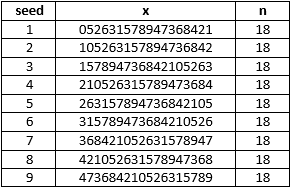1 move, big change
Suppose x is an n -digit number having the property that the value of x is doubled if the last digit of x is moved to the front.
Find the smallest possible value of n
The answer is 18.
This section requires Javascript.
You are seeing this because something didn't load right. We suggest you, (a) try
refreshing the page, (b) enabling javascript if it is disabled on your browser and,
finally, (c)
loading the
non-javascript version of this page
. We're sorry about the hassle.
2 solutions
One solution for n = 1 8 is x = 1 0 5 2 6 3 1 5 7 8 9 4 7 3 6 8 4 2 , since:

This x value can be found with its last digit 2 as a seed using the following algorithm. First, start with the seed 2 and add it to itself to obtain 2 + 2 = 4 .

Then take the 4 and place it in the next column and add it to itself to obtain 4 + 4 = 8 .

Then take the 8 and place it in the next column and add it to itself to obtain 8 + 8 = 1 6 . Put down the 6 and carry the 1 .

Then take the 6 and place it in the next column and add it to itself (along with the carried 1 ) to obtain 6 + 6 + 1 = 1 3 . Put down the 3 and carry the 1 .

Continue this process until you obtain the original seed 2 (without a carried 1 ). The result, with 1 8 digits, is the first image in this solution.
Now we can use this algorithm to test all 1 0 digits and show that if it is possible they all result in solutions with 1 8 digits:

(Exceptions: The seed 0 results in x = 0 , which does not have a last digit to move to the front, so it is discounted. Also, technically the seed 1 results in an x value with a leading 0 , but the leading 0 is necessary for the 2 x value, so the number of digits is still n = 1 8 .)
Since all possible seeds result in solutions x values with 1 8 digits, the smallest possible n value is n = 1 8 .
Incidentally, all the possible solutions for x have all the digits in the same order, and is an 18-digit cyclic number .
Let b be the last digit of a number 1 0 a + b . Then for some x
1 0 x b + a = 2 ( 1 0 a + b )
which means that
b = 1 0 x − 2 1 9 a
Since b is a single digit, the smallest x for which 1 0 x − 2 has 1 9 as a factor is x = 1 7 , so that the number is
5 2 6 3 1 5 7 8 9 4 7 3 6 8 4 2 0 b + b
Since b = 1 leads to 5 2 6 3 1 5 7 8 9 4 7 3 6 8 4 2 1 , the double of which is 1 0 5 2 6 3 1 5 7 8 9 4 7 3 6 8 4 2 , we try the next value b = 2 , which leads to
1 0 5 2 6 3 1 5 7 8 9 4 7 3 6 8 4 2 , the double of which is 2 1 0 5 2 6 3 1 5 7 8 9 4 7 3 6 8 4